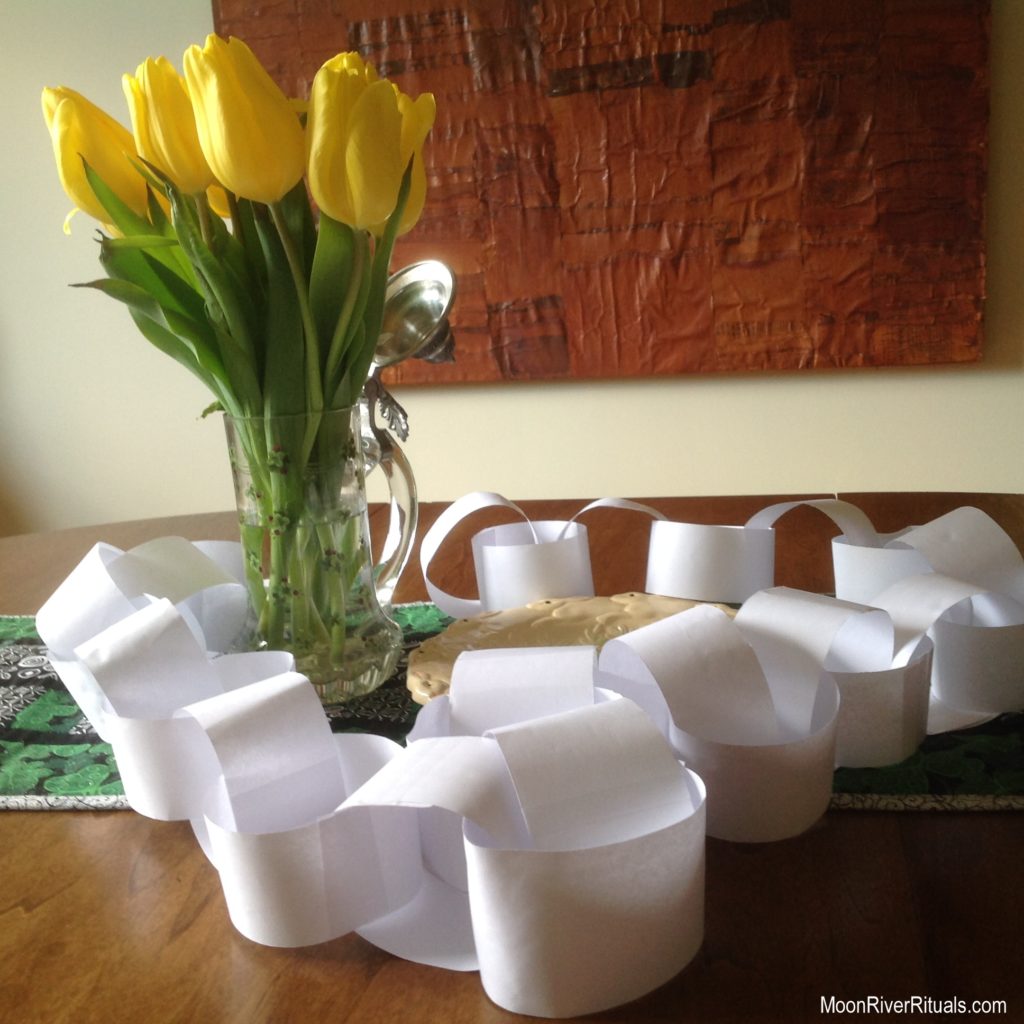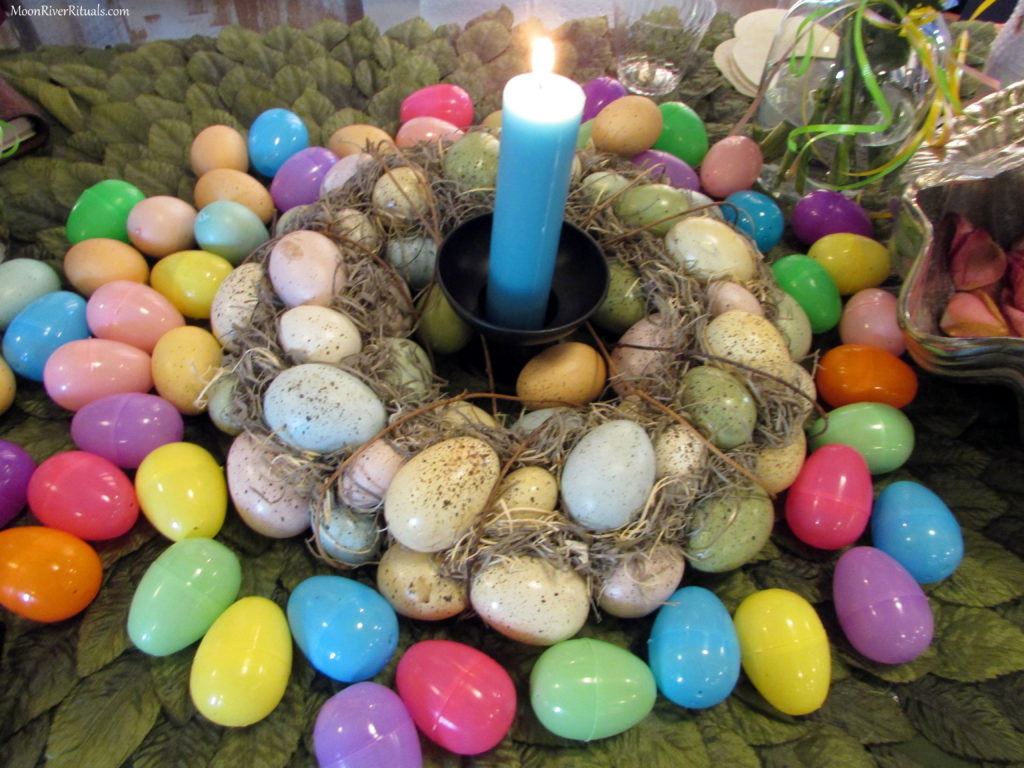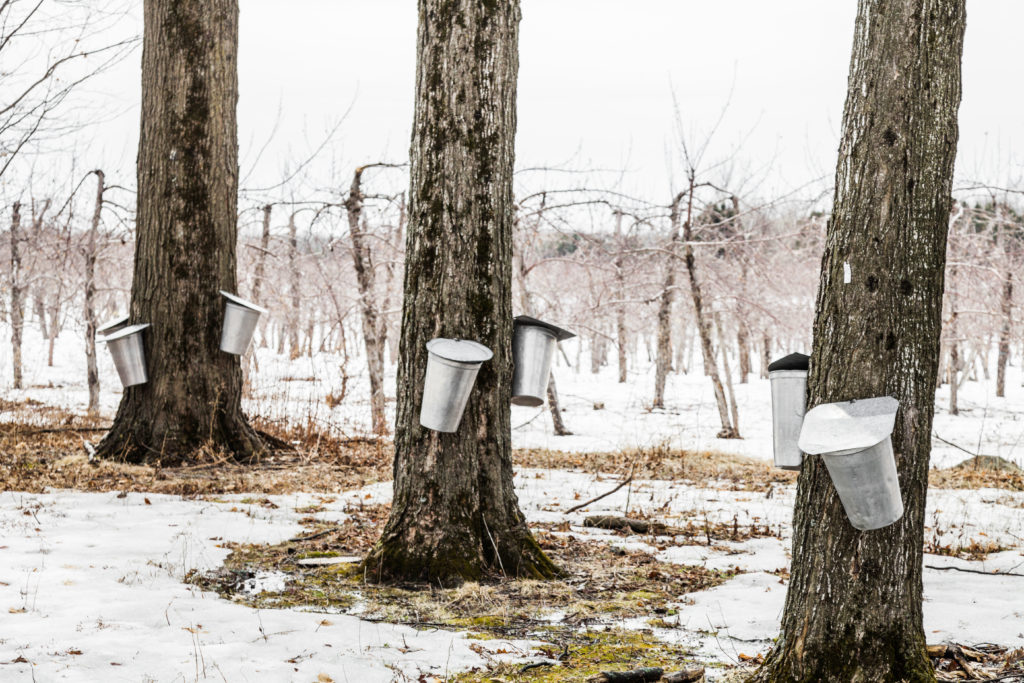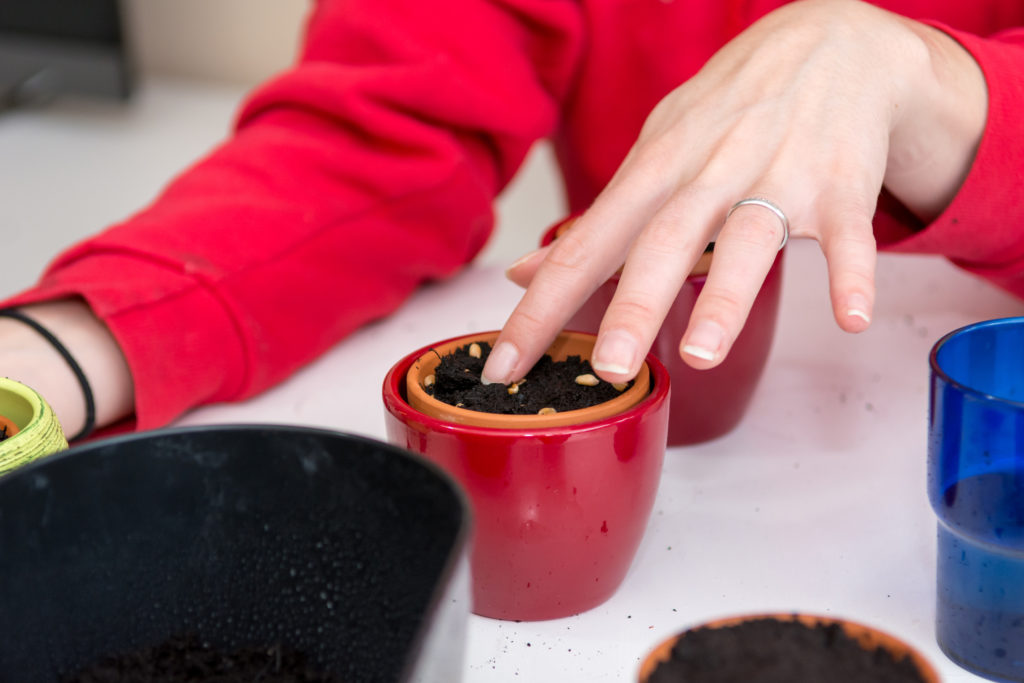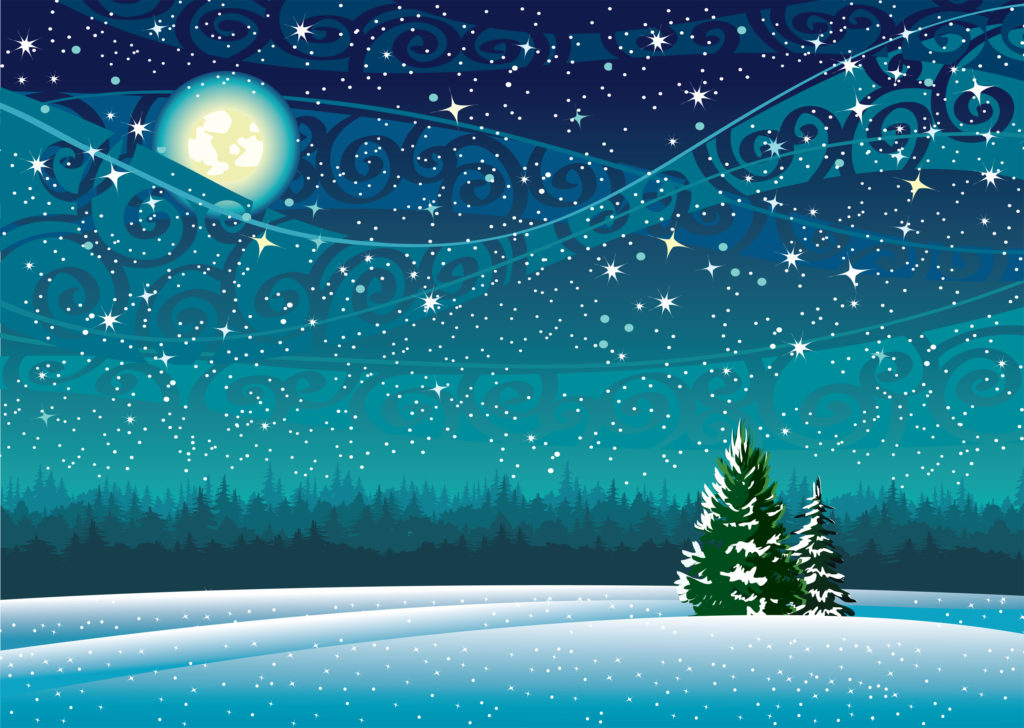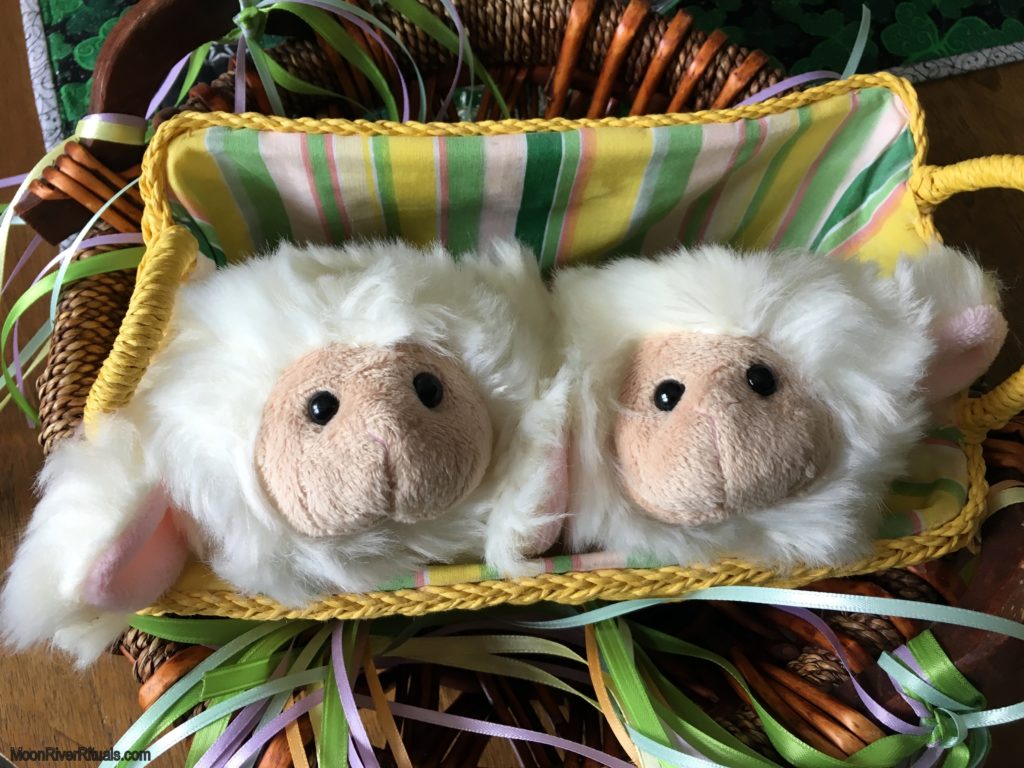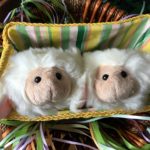
Fairies, flowers, fertility, a Maypole, and a hawthorn tree. They all weave their way into the Celtic festival of Beltane and other seasonal festivals so common in the Old World. On episode 18 of the Ritual Recipes podcast, I talk about the public ritual I created to celebrate Beltane here in central Connecticut where I live. It was about shadow gifts from the Beltane fairies, something we might need in order to be our authentic selves.
I also touch on the story of Bloddeuwedd (“bluh DIE weth”), the woman created from nine ingredients by two magicians determined to make the perfect bride for a young man who’d been cursed. I add my own two cents based on the magical meaning behind each of the ingredients. I talk about violence, punishment, and the dramatic transformation Bloddeuwedd goes through, first becoming an owl, then Goddess of the Hawthorn. You see, as that perfect bride, things went well…for a while…until she met another man and fell in love.
But first…What is ritual? To me, ritual is a visible act performed with invisible intent. If you’ve ever made a wish and blown out the candles on a birthday cake, you’ve performed a ritual. It can be that simple. It can also be more elaborate, a real community celebration.
THE HAWTHORN TREE
Earlier this year, I led a public ritual to celebrate Beltane. It wasn’t feasible to erect an actual Maypole, so I designed the ritual around the magical properties of the hawthorn tree, well known as the home of the fairies.

The hawthorn is a relatively small tree, known to live for a long time, some as long as 400 years. The hawthorn has a lot of foliage, making it an ideal home for birds as well as fairies.
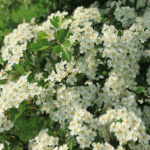
In the spring, the hawthorn blooms with a profusion of small white flowers. The stamens have bright pink heads. Some accounts of the hawthorn describe the scent as particularly female. In the old days, a bride would carry a sprig of flowering hawthorn on her wedding day to symbolize her desire for a fruitful union.
When summer comes, each hawthorn flower produces a fruit called a “haw.” In autumn, the haws turn bright red. They look like little apples. The tree becomes a banquet for the birds.
Since birds were known to carry messages to the Spirit World, a tree that fed them was sacred. In addition to the “haws,” the tree also has thorns, hence the name, haw-thorn.
My Celtic ancestors likely believed that wherever you find the oak, ash and hawthorn trees together, you can be sure the fairies are nearby. In fact, fairies are said to live beneath the hawthorn itself. The tree was considered so sacred that it was a serious crime to cut one down.
That might seem extreme until you realize that when the deceased were buried, their spirits would travel to the Underworld. From there, those spirits – now called Ancestors – would guide and protect the living back here in the mundane world. The fairies kept the connections between the worlds alive. So, it you destroyed the home of the fairies, you severed the connection to your ancestors and all hope of their guidance and protection. Not prudent, to say the least.
THE MAY QUEEN, THE GODDESS BLODDEUWEDD
There’s another reason why a community would revere a hawthorn tree. In his book, The White Goddess, author Robert Graves writes that the Hawthorn is protected by a goddess, Bloddeuwedd, known as the May Queen. Bloddeuwedd was created by the magicians Math and Gwydion from nine different ingredients, most of them plants, trees, or flowers: oak, meadowsweet, broom, cockle, bean, nettle, chestnut, primrose, and hawthorn.
A quick look into A Compendium of Herbal Magick by Paul Beyerl is illuminating. While each of the nine flowers and trees has many attributes, here are a few I found that seem to fit the creation of a perfect bride, from the viewpoint of the male magicians. (Of course, not having been a male magician, I’m just guessing.) Some of the attributes are from Beyerl, some from A Modern Herbal by Mrs. M. Grieve, and others.
Oak: for fertility and long life. Subtext: She won’t die in childbirth.
Meadowsweet: for acquiring a merry heart, with extra joy and blessings to a new bride. Subtext. Meadowsweet for a wife who won’t nag.
Broom: for good fortune and for accepting the changes that life brings. Upon further investigation, I saw subtext about broom, too. Might it have been added to ensure the bride would keep a clean house?
Cockle: As I mention in the podcast, I didn’t find any reference to a flower or plant or tree named cockle. So I must assume the inclusion of cockle in the concoction used to create Bloddeuwedd referred to the shellfish, believed by many to be an aphrodisiac. Makes sense.
Bean: for male virility. More subtext. If Bloddeuwedd was created to be the perfect bride and one of her ingredients was to enhance male virility, does that make her a form of Viagra?
Nettle: for healing. Having someone in the family know how to heal would certainly be a benefit. Subtext: She will be able to care for him when he’s ill, wounded, and old.
Chestnut: for male potency. Further reading about the chestnut associate it with humility, with finding satisfaction in little things. Subtext: a perfect wife won’t demand a lot of his attention.
Primrose: for inner and outer beauty. Self-explanatory.
Hawthorn: for female sexuality. Yes, there were plenty of other attributes of the hawthorn I could have mentioned here; but, I find this one key to the story of Bloddeuwedd’s journey to becoming her authentic self.
The magicians created Bloddeuwedd to be the bride of a young man, Llew. His mother had abandoned him and cursed him, saying he would never wed a mortal woman. (That’s a story for another time.) The magicians wanted Llew to be happy. Hence, the creation of Bloddeuwedd who was said to possess in abundance every trait and feature a man would want in a wife.
As planned, Llew marries Bloddeuwedd. Married life seems okay … for a while…until she meets another man. As the story goes, Bloddeuwedd comes alive in a way she’s never known before. My guess is she had her first orgasm, apparently not something the magicians thought to ensure Llew could give.
As the tale unfolds, she and her lover kill Llew. The authorities come after her. The magician Gwydion overtakes her and turns her into a white owl. (Picture a white owl with a round face, sometimes called a flower-faced owl. The name Bloddeuwedd also means flower-faced.)

That chapter in Bloddeuwedd’s story could explain why some people associate owls with death. I think a more fitting association is that of the woman who embraces the death of her old “self,” one defined by others, in favor of a new self, one who doesn’t fear being alone, one who finds wisdom in her experiences, one who realizes beauty is fleeting, one who discovers her own inner power, even if embracing that power means she will live a solitary life. Think of Sansa at the end of Game of Thrones. I won’t say any more in case you haven’t seen it yet. But I will say the stories of both Sansa and Bloddeuwedd show powerful personal transformation at great cost. Both stories are about gaining wisdom and the early concept of the virgin — the one who is whole unto herself.
I also wonder if Gwydion himself loved Bloddeuwedd, perhaps the way a parent loves a child. Maybe he sought to capture her so that he could determine her fate. On the website druidry.org, the ancient meaning for Bloddeuwedd is said to be owl, symbol of wisdom. Did Gwydion set her apart from other birds so that only the worthy, strong, and pure of heart would recognize her gifts? I’m simply speculating. Did I tell you that when I was in the seventh grade, I was crowned the May Queen? Or that the first gift my now-husband gave to me some 40 years ago was a necklace with a gold owl?
TREES
Trees in general play a key role in Celtic mythology. In fact, their calendar is based on trees with May being the 6th month, running from what we would calculate as approximately May 13 to June 9. The tree that represents May is, of course, the hawthorn.
Trees were also used to develop an alphabet, with letters formed by placing branches in certain formations. That alphabet is spelled o.g.h.a.m and is pronounced “OH-um.” The hawthorn tree is symbolized by the 6th consonant. It’s spelled h.u.a.t.h.e (or simply u.a.t.h.) and pronounced “HOO-ah.”
The hawthorn tree, so important to the fairies and the ancestors carries the energy of cleansing and preparing, both things and thoughts. Simply being near a Hawthorn is said to invite stillness and clear the mind. Some say people feel more patient when near a hawthorn.
The hawthorn also symbolizes hope. Early Christian stories suggest the thorns of the hawthorn were used on the head of Christ at his crucifixion. My guess is that different communities embrace different stories. Perhaps it was that Christian story that inspired the Pilgrims, back in 1602, to sail on a ship named Mayflower. Or maybe it was because they knew they’d need to have patience for the long voyage.
I wasn’t on the Mayflower, at least not that I remember, but I’m sure the stars were an important tool in navigation. Legend says that the Welsh Goddess Olwen, known as the White Goddess of the Hawthorn Tree, once walked through the empty universe trailing white hawthorn petals. The petals became the Milky Way. That’ just one of many beautiful star stories.
THE BELTANE RITUAL
For this year’s Beltane ritual, needed four fairies, one for each of the four directions. Fortunately, there were four girls at the ritual, preteens and young teens. With their mothers’ permission, I gave each girl a basket of ribbons. The ribbons in each basket were about 18 inches long, all one color.
The Fairy of the East represented air. Her ribbons were yellow.
The Fairy of the South represented fire. Her ribbons were red.
The Fairy of the West represented water. Her ribbons were blue.
The Fairy of the North represented earth. Her ribbons were green.
I talked about how Fairies live under the hawthorn tree and how they had come to our ritual to give each participant three gifts, each gift symbolized by the color of the ribbon.
I asked each Fairy to describe the gift embodied in her ribbon. Prior to the ritual, I had typed this information on individual cards. All each Fairy had to do now was read from the card.
The East Fairy, with yellow ribbons representing air said: To think and speak with clarity, by fairy magick it shall be!
The South Fairy, with red ribbons representing fire said: For courage bright, for energy, by fairy magick it shall be!
The West Fairy, with blue ribbons representing water said: For compassion, forgiveness and mystery, by fairy magick it shall be!
The North Fairy, with green ribbons representing earth said: For growth and for prosperity, by fairy magick it shall be!
Three gifts. Four fairies. I’ll get back to that in a moment.
I held the ritual at Meg’s Inspirations, a local gift shop and spiritual boutique in Manchester CT, where I live. I told everyone that if we were holding the ritual next to a hawthorn tree, we would imbue our ribbons with our intent, our honest intent, and spear each ribbon on one of the thorns – because the thorns are blessed with fairy magick. Instead, I improvised with an umbrella stand filled with long, skinny branches, some from a local crafts store, some from the nature center near my home. These branches did not have thorns.
Each person picked ribbons from three fairies. We talked about the gifts we’d chosen and how we would use them in our lives.
Then I asked everyone to think of the ribbon they did not pick. I suggested that the gift not chosen – the shadow gift – might well be the gift most needed. I said to them:
Go now to your fourth fairy and receive your shadow ribbon. Think about it carefully. If you’re ready to explore the magick offered by that fairy’s gift, then hang the ribbon on the hawthorn tree.
On the night of the ritual, I didn’t tell the story of Bloddeuwedd. But I do invite you now to remember the struggle and the power of being your authentic self.
We spent time sharing our thoughts about our shadow ribbon. We speculated about the gift we might find in the shadow. Most of us speculated silently. Some things are too private, too raw, to share. That’s okay. The transformation of a ritual doesn’t always happen in the moment.
TERROR
In her book, Voice of the Trees, a companion book to an oracle deck, author and illustrator Mickie Mueller shares ways to work with the messages the trees have for us. When she writes about the hawthorn, she notes that the Celtic name, huathe, “HOO-ah,” means “terror.” The oracle card for the hawthorn warns of obstacles along the path, or tension of some kind. Mueller says you don’t apply force when encountering the obstacle. It will eventually yield a gift, but wisdom is needed first. (Think of Bloddeuwedd!) Of course, I don’t think it’s a good idea to apply force when dealing with any plant that has thorns.
MAKING FAIRIES WITH MY HUSBAND
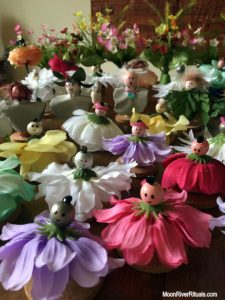
I’ve been leading seasonal rituals at Meg’s for over 10 years. A month or so before the ritual, Meg enthusiastically announces “The Fairies of Beltane are coming!” We always get a good turnout. That’s because everyone knows that if they come to the ritual, they get to take home one of the fairies. So every year, I make new fairies.
About six weeks before each Beltane ritual, I pull out my craft supplies. First, I paint wooden balls and cones for the multicultural heads and bodies. Then I add artificial flowers, beads, scraps of leather, feathers, glitter, whatever calls to me in the moment.
Three years ago, I recruited my husband to help me paint the wooden heads and bodies. He had such a good time he helped me paint fairies again the following year. This year was different. The Alzheimer’s Disease is advancing. Instead of painting, he lined up the finished fairies on the dining room table so I could take photos.

People who have attended several of my Beltane rituals tell me they have their fairies on a desk, a shelf, a dresser, a dashboard. I have one on the windowsill above the kitchen sink. I see her every day, many times. When I do, I’m reminded of how I gather each May with friends, some I’ve known for many years, some I’ve just met. I’ve celebrated Beltane in a welcoming gift shop, on the beach, in a basement, and in a clearing in the woods. I’ve filled baskets with flowers and planted flowers around a sacred garden. I’ve brought a potluck offering to a Beltane feast, and danced the Maypole with dozens of friends. It’s been years since I’ve done some of those activities. Seeing my little Beltane fairy brings back all the memories, especially the memories of painting fairies with my husband.
SUMMER SOLSTICE
A few weeks later, I led another seasonal ritual, this time to celebrate the Summer Solstice, a time often referred to as Midsummer. In many parts of Europe, what we think of as a Maypole was also part of Midsummer festivities.
Flowers are a key element of both Beltane and Midsummer. In her book, Midsummer: Magical Celebrations of the Summer Solstice, author Anna Franklin talks about the long-held custom in Britain of placing flowers on the largest stone on a farm. Then and now, stones symbolize the realm of the ancestors.
I’m reminded of “worry stones,” the pocket-sized stones with a thumb-sized indentation just right for rubbing. I don’t doubt the physical act of rubbing the stone can help ease a troubled mind. Next time, while you’re rubbing the stone, ask your ancestors, the known and the unknown, to help you. The addition of adding that intent creates a ritual. It can be as simple as that. I’ll tell you about the Summer Solstice ritual on the next episode.
Until then, how about you? Are you ready to connect with the cycles of nature? Honor the spirit of the ancestors? Discover the patterns of your life? Establish your own family traditions? Be transformed? Are you ready to do something to add positive energy to the world., I hope so. The world needs what you have to give.
How do you use rituals? Did anything about the story of Bloddeuweth resonate with you? Send an email to: zita@moonriverrituals.com or connect with me on Instagram (ZitaChristian) or Facebook (MoonRiverRituals).
Thanks for being here.

